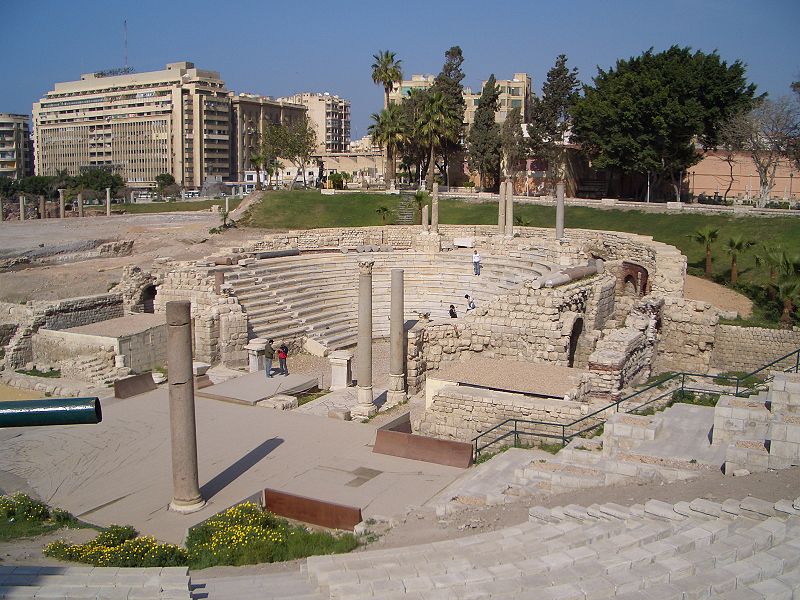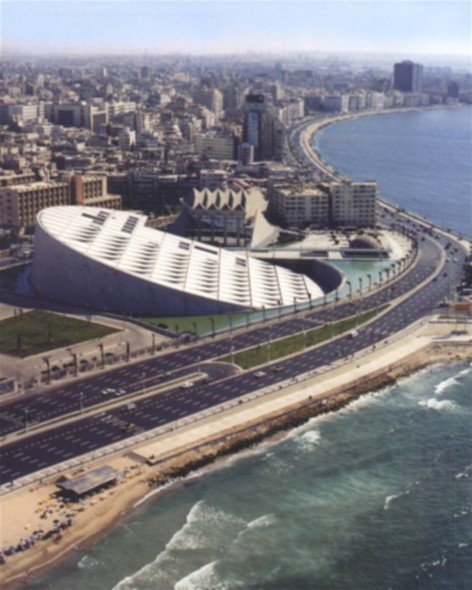Alexandria
Alexandria (Arabic: الإسكندرية al-Iskanderiyya) is Egypt's second largest city (3.5 million people), its largest seaport and the country's window onto the Mediterranean Sea. It's a faded shade of its former glorious cosmopolitan self, but still worth a visit for its many cultural attractions and still-palpable glimpses of its past.
Understand
History
Lighthouse of Alexandria
Library of Alexandria
Few cities of the world have a history as rich as that of Alexandria; few cities have witnessed so many historic events and legends. Founded by Alexander the Great (Iskander al-Akbar) in 331 BC, Alexandria became the capital of Greco-Roman Egypt; its status as a beacon of culture is symbolized by Pharos, the legendry lighthouse that was one of the Seven Wonders of the World.
The Lighthouse of Alexandria (Pharos) was built in the third century BC by Ptolemy I on the island of Pharos. The height of the lighthouse was between 115 and 150 meters, so it was among the highest structures in the world, second only to the Great Pyramids. The lighthouse was built on 3 floors: a square bottom with a central heart, a section octagonal average and above an upper section. And on the top there was a mirror that reflected sunlight during the day and used fire for the night. But it was damaged by 2 earthquakes in 1303 and 1323.
The Library of Alexandria was the largest library of the ancient world and the place where great philosophers and scientists of that age came to seek knowledge. Alexandria also hosted, at the time, the largest Jewish community in the world, and the Septuagint, the first Greek translation of the Hebrew Bible, was written in the city.
In all, Alexandria was one of the greatest cities in the Hellenic world, second only to Rome in size and wealth, and while it changed hands from Rome to Byzantine and finally Persia, the city stayed the capital of Egypt for a millennium.
Alas, the city's reign came to an end when the Arabs conquered Egypt in 641 and decided to found a new capital to the south in Cairo. (Scholars still debate if this was when the Library was finally destroyed; it is known that the Library was, at the very least, sacked and badly damaged by the Romans themselves in 48 BC, c. 270, and once more in 391.)
Alexandria survived as a trading port; Marco Polo described it around 1300 as one of the world's two busiest ports, along with Quanzhou. However, its strategic location meant that every army on its way to Egypt passed through: Napoleon's troops stormed the city in 1798, but the British conquered it in the Siege of Alexandria in 1801. The Egyptians under Mohammed Ali took control of the city and rebuilt it, but the Orabi Rebellion in 1881 and massacres of Europeans in the city led the British to strike back and hammer the rebels with the three-day Bombardment of Alexandria, reducing much of the city center to rubble.
Once again, Alexandria rose from the ashes. Its cosmopolitan and decadent lifestyle before and during World War II gave birth to its greatest poet, Constantine P. Cavafy, and was chronicled in Laurence Durrell's Alexandria Quartet and a series of works by E. M. Forster including Alexandria: A History and Guide (1922), described by some as the best travel guide ever written.
Yet this world, too, took a shattering blow in the 1950s when Egypt's new fiercely nationalist leader Gamal Abdel Nasser nationalized vast swathes of the economy and forbade foreigners from owning or running companies, effectively forcing tens of thousands of foreigners out of the country, including virtually all of Alexandria's once 150,000-strong Greek community.
Today's Alexandria is a dusty seaside Egyptian town with an over-inflated population of 5 million, yet its status as Egypt's leading port keeps business humming, and tourists still flock to the beaches in the summertime. And while much of the city is badly in need of a lick of paint, history both ancient and modern is everywhere if you peer closely enough: the French-style parks and the occasional French street sign survive as a legacy of Napoleon, one of Alexandria's many conquerors, and the few remaining Greek restaurants and cafés still dominate the cultural scene.
Climate
Alexandria has a Mediterranean climate, with warm humid summers and mild rainy winters. The daytime can be humid in summer, with summer temperatures averaging 31°C (88°F), but evenings are usually cooler and breezy, especially by the Corniche. Winters can get cold, with daytime highs down sometimes to 12°C (53°F), with ocassional rain and sometimes hail. Humidity is high throughout the year. The best time to visit Alexandria is in spring (March-June) and autumn (September-November), since it's at its busiest in summer, when Egyptians flock down to escape the searing heat of Cairo.
Orientation
Alexandria's primary promenade is the seaside Corniche. At the western tip lies the fort of Qait Bey, built near the presumed site of the former Lighthouse (Pharos in Greek), one of the Seven Wonders of the Ancient World, while the eastern shore sprawls for miles on end with the slums and tenements of modern Alex.
Get in
Map of central Alexandria
Alexandria is easily reached by plane, train or bus.
By plane
Since December 2011, Alexandria's main airport is Borg el Arab Airport (IATA: HBE), serving mainly destinations in the Middle-East and North Africa, but also Milano-Bergamo (Air Arabia), Athens (Egypt Air), Istanbul and Beyrouth. It's not very conveniently located some 45 km (23 mi) to the south-west of Alexandria.
Getting to and from the airport is a major concern as there are few affordable options to get to Alexandria. In most cases a taxi service will be needed (cost 130 to 160LE, or 15-20 Euros). The only other option are the two daily buses in each direction (9am, 2pm from Alexandria bus station and 10:30am and 4:30pm from the airport; cost around 10LE). From the Alexandria bus station to downtown Alexandria (or the other way around) a taxi costs 10-15LE. However, these buses have no longer been available since before January 2014. For travelers on a budget, it would often be cheaper to fly into Cairo and take a bus or train to Alexandria (see below).
The airport has no official website (the ones that are online are from private operators), but for information it is possible to contact the very helpful English speaking information desk. From abroad 002-03-46-31-010 (or try with last digits 1-2 or 3)
To reserve a taxi there is only one taxi service located in the airport. El Mistria travel 002-010-067-817-85.
Other taxi drivers are to be found outside, but beware of taxi drivers offering prices lower than 130LE, as they sometimes pronounce "One zero six pounds" really meaning 160LE. Egyptians also may say "one hundred and half", meaning 150.
By bus
Several bus companies offer a bus service into Alexandria at a very low price range: 20-35 LE. Buses are air conditioned and come complete with a hostess trolley service. Companies include Golden Arrow, West Delta, Super Jet, Pullman and El Gouna. Operating times vary from one company to another, but there are trips between Cairo and Alexandria virtually every hour from early morning untill midnight.
Note that while the buses themselves are perfectly comfortable, the duration of your journey from Cairo to Alexandria (and vice versa) will depend on your pick-up/drop-off point. Most buses start out from the Almaza Bus Station in Heliopolis and stop by Midan Tahrir and Giza before finally setting out to Alexandria; if you join from Heliopolis expect a 4-5 hour trip rather than the average 2-3.
There are a number of bus pick-up/drop-off points inside Alexandria. These are usually either at Maw'if Gadid Station (except El Gouna, which uses Sidi Gaber station) which is a bit far from the city of Alexandria so it shouldn't cost more than a 10 LE cab ride, 15 LE max. Don't take a taxi with anyone that approaches you right outside of the bus. Walk outside the station and catch a taxi there if you must. There is also a bus from Maw'if Gadid to Sidi Gabr, and from Sidi Gabr most parts of the city are accessible by minibus or tram if you are looking to save money. The bus fare will run you 50 piasters.
By train
From Cairo, frequent trains from Ramses Station are probably the best way to get to Alexandria. Trains run at least once every hour from 6 AM to 10 PM, but try to choose either an express or the pride of Egyptian Railways, the French-built Turbo, which takes only 2 hours 10 minutes for the journey. 1st class AC tickets cost 36-52LE one-way and 2nd class tickets range from 19 to 36LE, depending on the train. Reservation is obligatory in express trains. It's best to buy a ticket the day before at the train station or online from the Egyptian railways website [31]
Although it is not advised to do so, some travelers have managed to get on the ordinary non AC 2nd and 3rd class trains. Tickets for these trains are not sold to foreigners at ticket counters or online. The only way to ride these extremely packed trains is to hop on and pay on board.
From Alexandria, trains depart from Misr Station, a 10-minute stroll south of the Corniche along Nabi Daniel St, as well as the Sidi Gaber Station.
There are no more trains from Mersa Matruh to Alexandria.
By car
There are two options when traveling from Cairo to Alexandria by car. Using either route, the journey usually takes around 3 hours, depending on speed and surrounding traffic.
The Agriculture road has a speed limit of 90 km/hr for private cars and has 4 lanes in each direction. This is the main road, so it can get a little crowded. Also offers access to Damnhour and Tanta.
The Desert road has a speed limit of 100 km/hr for private cars and has 4 lanes in each direction. True to the name, this crosses the desert and is less crowded and faster. There are cafeterias every few kilometers.
The usual cautions for driving in Egypt apply; see Egypt for details.
By boat
Visemar Lines [32] operates a weekly passanger ferry from Venice to Alexandrias, via Tartus in Syria. Depature time is every Wednesday at 4PM, arriving the following Sunday at 2PM, this is the only way of reaching Egypt direct from Europe. However, the ferry have been canceled.
Get around
Alexandria is quite a long city; you can get pretty much anywhere by using the local transportation available along the Corniche. 

now 📣
follow @steemit-earn for more earning lessons